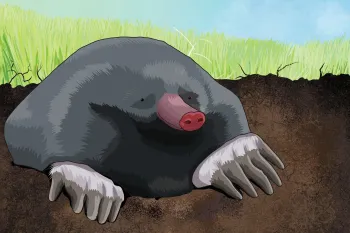Shrews and other underground dwellers are always welcome in Goldman’s habitat, where she has found nests beneath decaying wood and weeds. “I leave them alone because I respect their life and I love having whoever wants to hang out here with me join me,” she says. But she recently had an epiphany: Voracious consumers of insects, earthworms, centipedes and millipedes, shrews are also on patrol for plant-eating mollusks. “I happen to love snails and slugs—I think they’re cool. But it dawned on me the reason I hardly have any is I have so many shrews taking care of that for me.”
Goldman’s appreciation for small tunneling mammals is a refreshing divergence from conventional command-and-control, reactionary forms of gardening. It’s also smart. Animals who live their lives below the surface are better tillers, seeders, weeders and insect predators than we humans will ever be. The activities of shrews, moles, voles, chipmunks and mice sculpt the land, create habitat for birds and butterflies, and help regenerate whole forests.
Understanding the importance of subterranean gardeners requires adjusting our mental time frames and rejecting instant landscapes. In the short term, molehills might look like disruptive dirt piles. But committing the heretical act of leaving them alone brings beautiful rewards: friable soil, surprise wildflower sprouts and large moss beds underfoot, where birds can gather soft nesting material to keep their chicks cozy.
Small mammals even have a critical role in nurturing woodlands. By examining their scat, wildlife ecologist Ryan Stephens has discovered that different species of voles, mice and chipmunks are important dispersers of mycorrhizal fungi, which funnel water and nutrients to tree roots and other plants. These intricate relationships unfold even in my suburban yard, where last summer grape ferns—which are all but impossible to intentionally propagate—sprouted on our molehills. Their appearance is a mystery to me and to science; they can take years to develop and require certain mycorrhizal fungi to colonize their roots. But many wild neighbors likely played a part: Deer eat grape ferns and may have pooped out the spores. Moles probably covered those spores with soil, giving them needed darkness to germinate. And voles, who treat mole tunnels like highways, may have added the final ingredient in their scat: spores of the grape ferns’ mutualistic fungal partner.



